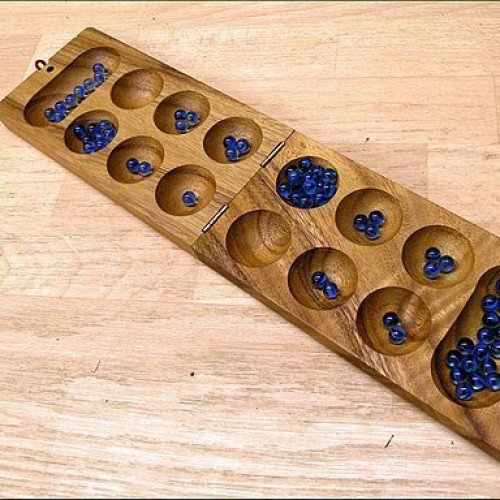KALAH VS SHATRANJ

KALAH
Kalah, also called Kalaha or Mancala, is a game in the mancala family invented in the United States by William Julius Champion, Jr. in 1940. This game is sometimes also called "Kalahari", possibly by false etymology from the Kalahari desert in Namibia. As the most popular and commercially available variant of mancala in the West, Kalah is also sometimes referred to as Warri or Awari, although those names more properly refer to the game Oware. For most of its variations, Kalah is a solved game with a first-player win if both players play perfect games. The Pie rule can be used to balance the first-player's advantage. Mark Rawlings has written a computer program to extensively analyze both the "standard" version of Kalah and the "empty capture" version, which is the primary variant. The analysis was made possible by the creation of the largest endgame databases ever made for Kalah. They include the perfect play result of all 38,902,940,896 positions with 34 or fewer seeds. In 2015, for the first time ever, each of the initial moves for the standard version of Kalah(6,4) and Kalah(6,5) have been quantified: Kalah(6,4) is a proven win by 8 for the first player and Kalah(6,5) is a proven win by 10 for the first player. In addition, Kalah(6,6) with the standard rules has been proven to be at least a win by 4. Further analysis of Kalah(6,6) with the standard rules is ongoing. For the "empty capture" version, Geoffrey Irving and Jeroen Donkers (2000) proved that Kalah(6,4) is a win by 10 for the first player with perfect play, and Kalah(6,5) is a win by 12 for the first player with perfect play. Anders Carstensen (2011) proved that Kalah(6,6) was a win for the first player. Mark Rawlings (2015) has extended these "empty capture" results by fully quantifying the initial moves for Kalah(6,4), Kalah(6,5), and Kalah(6,6). With searches totaling 106 days and over 55 trillion nodes, he has proven that Kalah(6,6) is a win by 2 for the first player with perfect play. This was a surprising result, given that the "4-seed" and "5-seed" variations are wins by 10 and 12, respectively. Kalah(6,6) is extremely deep and complex when compared to the 4-seed and 5-seed variations, which can now be solved in a fraction of a second and less than a minute, respectively.
Statistics for this Xoptio

SHATRANJ
Shatranj (Arabic: شطرنج; Persian: شترنج; from Middle Persian chatrang چترنگ) is an old form of chess, as played in the Sasanian Empire. Its origins are in the Indian game of chaturaṅga. Modern chess gradually developed from this game, as it was introduced to the western world by contacts in Muslim Al-Andalus (modern Spain) and in Sicily in the 10th century. The Persian word shatranj ultimately derives from Sanskrit (Sanskrit: चतुरङ्ग; caturaṅga) (catuḥ: "four"; anga: "arm"), referring to the game of the same name: Chaturanga. In Middle Persian the word appears as chatrang, with the 'u' lost due to syncope and the 'a' lost to apocope, such as in the title of the text Mâdayân î chatrang ("Book of Chess") from the 7th century AD. In Persian folk etymology, a Persian text refers to Shah Ardashir I, who ruled from 224–241, as a master of the game: Three books written in Pahlavi, Kar-Namag i Ardashir i Pabagan, Khosrow and ridag, and Wizārišn ī čhatrang ("Treatise on Chess"), also known as the Chatrang Nama ("Book of Chess"), all mention chatrang. In Kār-nāmak it is said that Ardashīr "with the help of the gods became more victorious and experienced than all others in polo, horsemanship, chess, backgammon, and other arts," and in the small treatise on Khosrow and ridag, the latter declares that he is superior to his comrades in chess, backgammon, and hašt pāy. Bozorgmehr, the author of Wizārišn ī čhatrang, describes how the game of chess was sent as a test to Khosrow I (r. 531-79) by the "king of the Hindus Dēvsarm" with the envoy Takhtarītūs and how the test was answered by the vizier Bozorgmehr, who in his turn invented the game Backgammon as a test for the Hindus. These three Middle Persian sources do not give any certain indication of the date when chess was introduced into Persia. The mentions of chess in Kar-Namag i Ardashir i Pabagan and Khosrow and ridag are simply conventional and may easily represent late Sasanian or even post-Sasanian redactions. According to Touraj Daryaee, Kar-Namag i Ardashir i Pabagan is from 6th century. Wizārišn ī čhatrang was written in the 6th century.